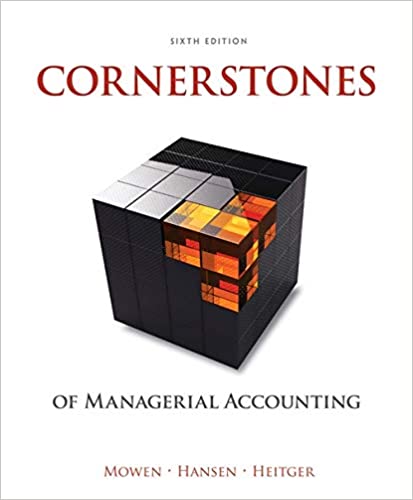
Cornerstones of Managerial Accounting 6th Edition by Maryanne Mowen,Don Hansen ,Dan Heitger
Edition 6ISBN: 978-1305103962
Cornerstones of Managerial Accounting 6th Edition by Maryanne Mowen,Don Hansen ,Dan Heitger
Edition 6ISBN: 978-1305103962 Exercise 15
Overhead Application, Overhead Variances
Moleno Company produces a single product and uses a standard cost system. The normal production volume is 120,000 units; each unit requires five direct labor hours at standard. Overhead is applied on the basis of direct labor hours. The budgeted overhead for the coming year is as follows:

During the year, Moleno produced 118,600 units, worked 592,300 direct labor hours, and incurred actual fixed overhead costs of $2,150,400 and actual variable overhead costs of $1,422,800.
Required:
1. Calculate the standard fixed overhead rate and the standard variable overhead rate.
2. Compute the applied fixed overhead and the applied variable overhead. What is the total fixed overhead variance? Total variable overhead variance?
3. CONCEPTUAL CONNECTION Break down the total fixed overhead variance into a spending variance and a volume variance. Discuss the significance of each.
4. CONCEPTUAL CONNECTION Compute the variable overhead spending and efficiency variances. Discuss the significance of each.
5. Journal entries for overhead variances were not discussed in this chapter. Typically, the overhead variance entries happen at the end of the year. Assume that applied fixed (variable) overhead is accumulated on the credit side of the fixed (variable) overhead control account. Actual fixed (variable) overhead costs are accumulated on the debit side of the respective control accounts. At the end of the year, the balance in each control account is the total fixed (variable) variance. Create accounts for each of the four overhead variances and close out the total variances to each of these four variance accounts. These four variance accounts are then usually closed to Cost of Goods Sold.
Form a group with two to four other students, and prepare the journal entries that isolate the four variances. Finally, prepare the journal entries that close these variances to Cost of Goods Sold.
Moleno Company produces a single product and uses a standard cost system. The normal production volume is 120,000 units; each unit requires five direct labor hours at standard. Overhead is applied on the basis of direct labor hours. The budgeted overhead for the coming year is as follows:

During the year, Moleno produced 118,600 units, worked 592,300 direct labor hours, and incurred actual fixed overhead costs of $2,150,400 and actual variable overhead costs of $1,422,800.
Required:
1. Calculate the standard fixed overhead rate and the standard variable overhead rate.
2. Compute the applied fixed overhead and the applied variable overhead. What is the total fixed overhead variance? Total variable overhead variance?
3. CONCEPTUAL CONNECTION Break down the total fixed overhead variance into a spending variance and a volume variance. Discuss the significance of each.
4. CONCEPTUAL CONNECTION Compute the variable overhead spending and efficiency variances. Discuss the significance of each.
5. Journal entries for overhead variances were not discussed in this chapter. Typically, the overhead variance entries happen at the end of the year. Assume that applied fixed (variable) overhead is accumulated on the credit side of the fixed (variable) overhead control account. Actual fixed (variable) overhead costs are accumulated on the debit side of the respective control accounts. At the end of the year, the balance in each control account is the total fixed (variable) variance. Create accounts for each of the four overhead variances and close out the total variances to each of these four variance accounts. These four variance accounts are then usually closed to Cost of Goods Sold.
Form a group with two to four other students, and prepare the journal entries that isolate the four variances. Finally, prepare the journal entries that close these variances to Cost of Goods Sold.
Explanation
Standard fixed overhead rate =
=
...
Cornerstones of Managerial Accounting 6th Edition by Maryanne Mowen,Don Hansen ,Dan Heitger
Why don’t you like this exercise?
Other Minimum 8 character and maximum 255 character
Character 255


